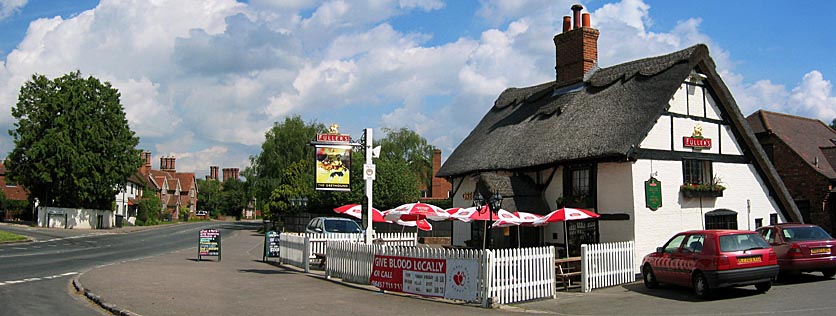 |
 |
|||
|
|
Tidmarsh where Lords fought Law Suits
Mention of this roadside settlement is first found in 1196. It is almost certainly a Saxon village which grew up along what is now the A340, but is supposedly, in origin, an old Roman road running north from Silchester to a river crossing at Pangbourne (although the southern portion of this highway has been artificially straightened in more recent times). The place-name has a number of suggested meanings. Tithe Marsh is appealing but sounds more medieval than Saxon. Being named after a man called Tydda is just boring, although Dydda could be the Saxon King of Northern Wessex and father of St. Frideswide. ‘Common Marsh’ seems to be the most likely. Although, a Celtic alternative would be 'Tyddyn March' meaning 'Small Farm for Horses' perhaps referring to a roman posting station. The most famous building in the village is the ancient Greyhound Inn. A fine example of 12th century cruck construction, this little thatched cottage became a wayside public house in 1625. The old house called ‘Bere Sizes’ is said to have belonged to the monks of Reading Abbey. This may be related to the vineyard which they are recorded to have tended in the parish in the mid-13th century. The Abbot certainly had his favourite Summer residence at nearby Pangbourne and was the overlord of Tidmarsh Mill. The house, then called ‘Wynhird,’ and its associated garden at the vineyard, was, however, given to a certain Gunnora de Bendenges in 1239. This lady was embroiled in a shocking 13th century court case in which she claimed to be the widow of the lord of the manor, John de Tidmarsh; despite the fact that, Maud de Berners, the mother of John’s son and heir, Geoffrey, was already enjoying all the rights of privileges of that position. Maud claimed that Gunnora’s marriage was a sham and her daughter, Juliane, illegitimate. But, when she failed to turn up to the second hearing, the court proclaimed in Gunnora’s favour and she was given a third of the manor! The old manor house stood on the site of Tidmarsh Grange, next to the parish church, but was transferred to the hill above the village in the 19th century. It was part of the Honour of Wallingford and held in return for providing a knight to help garrison the castle there for forty days in time of war. From early times, Tidmarsh Manor had its own fishery and this was later joined by other means of providing sustenance: a rabbit warren and a dovecote. The Tidmarshes had lived there until 1407 when it was sold, eventually coming into the hands of the Rothwells and their heirs, the Leynhams, whose fine brass memorials can still be seen in the church. Tidmarsh Church is an unexpected treasure. It has one of the most superbly carved Norman doorways in the county. There is a fine contemporary font to match which was found buried in the churchyard in Victorian times. The building is unusual in having one of the few apses in the county. Some think this may be built over a Saxon original, as its polygonal plan is similar to the existing Saxon example at Wing in Buckinghamshire.
|
|||
| © Nash Ford Publishing 2004. All Rights Reserved. | ||||



